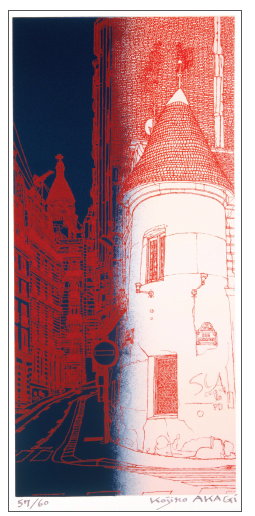Rue du Mont-Cenis / Rue du Mont-Cenis / モンスニ通り(モンマルトル)
Dublin Core
Titre
Rue du Mont-Cenis / Rue du Mont-Cenis / モンスニ通り(モンマルトル)
Sujet
Rue, Sérigraphie
Description
Au numéro 2 de cette rue, se dresse le plus haut sommet de Paris, à une altitude de 129,39 m. Cette colline offre la plus belle vue sur la ville. Les hauteurs de Montmartre ont depuis toujours attiré l’attention et la curiosité. A l’époque où Paris était une colonie romaine, un temple dédié à Mercure, dieu du commerce, était érigé sur cette colline. Après l’arrivée du christianisme, vers l’an 250, Saint Denis, le premier évêque de Paris y mourut en martyr. C’est sur cette colline qu’il fut décapité et réalisa un miracle en marchant vers le nord avec sa tête sous le bras. L’endroit où il s’arrêta pour mourir est devenu la ville de Saint-Denis. Plus tard, on a construit à Saint-Denis une grande basilique de style gothique qui sert également de nécropole aux rois de France. On peut apercevoir son toit vert en venant de l’aéroport Roissy-Charles de Gaulle, au niveau du Stade de France, juste avant d’arriver à Paris. La rue du Mont-Cenis a une longue histoire. Selon la légende, c’était le chemin parcouru par ce saint. Une archive du 13e siècle indique que seuls les hommes ou les ânes pouvaient emprunter cette ruelle.La tour cylindrique que l’on peut voir au numéro 16, au pied de la rue conduisant à la colline de Montmartre, côté nord, était le pigeonnier d’un ancien propriétaire agricole. A l’époque, posséder des pigeons était un symbole de pouvoir, car il fallait une certaine surface de terre pour cultiver les grains nécessaires à les nourrir. Une autorisation du seigneur féodal était nécessaire ; elle déterminait le nombre de pigeons que l’on peut posséder selon la surface du champ. On peut ainsi imaginer que le propriétaire de cette tour était très puissant. Son acte de cession est conservé et date de 1480. Utrillo, né dans ce quartier proche de la mairie du 18e, a également dessiné ce monument.
Along this street house number 2 is the highest point, 129.39 m above sea level. In fact it is the highest of all the hills in Paris, meaning that it is the best viewpoint. Marutoru hill has been popular for a long time and a temple to worship Mercure, the god of prosperous business, was built in Roman colonial era. Christianity entered Paris and in around 250 and Saint-Denis, Paris’ first bishop, was martyred by being beheaded on this hill. It was said that a miracle occurred when he picked up his head and started to walk north. This sacred ground is where he collapsed. A church, typical of the French gothic style, was built there and is currently the cemetery of the French Royal Family. When travelling from Roissy airport, just before entering Paris, there is the French Stadium. The green roofing of the church can clearly be seen from here. The Saint was said to have walked along this street. According to the 13th century records the street was a narrow path, just wide enough for donkeys and humans.The tube-shaped tower on this work used to be in number 63, under Montmartre hill on the north side. It was part of the landlord’s property, used as a pigeon coop. The number of pigeons was a symbol of the landlords’ wealth and power as the numbers were determined according to the size of their own farmlands where they fed the pigeons. Also, they had to obtain permission from the lord of the manor. A document to transfer ownership rights of this tower was signed in 1480. Utrillo also painted this building. There is a ward office nearby and Utrillo was born around this area.
この通りの二番地が、丘の一番高いところで、海抜百二十九・三九メートル、パリを巡る丘でも一番高く、眺めは最高ということになる。マルトル山は昔から目をつけられていて、パリがローマ植民地時代には、もうすでにメルキュール(商業の神様)を祭る神殿が建てられていたという。キリスト教が入って来て、西暦二五〇年ごろパリの初代司教だったサンドニ聖人が、殉教、この丘で首を刎ねられたが、その首を手に持ってトコトコと北に向かって歩き出し、パッタリと倒れたところが、現代の聖地サンドニで、そこに大きなフランスゴチック様式のお手本となる教会堂が建ち、フランス王家の菩提所となっている。ロアシー空港から、パリ市に入る手前に、フランス・スタジアムの当たりで、その緑の屋根が大きく見える。その聖人の歩いた道筋が、この通りだったというのだから古い。もっとも昔は、徒歩かロバでしか歩けない小道だったと、十三世紀頃の記録に残っているのだが。 この円筒の塔は、モンマルトルの丘下の北側、通りの六十三番地、昔あったあたりの地主農家の館の、鳩小屋だった。鳩は穀物を食べるので、鳩の飼えるのは、農地の広さ毎に、何羽と決まっていて、領主の許可が要ったから、勢力のシンボルで、相当有力な農家だったらしい。一四八〇年に売買の、権利譲渡の書類が残っている。ユトリロもこの建物を描いているし、そばに区役所があり、ユトリロの生まれたのも、この近くである。
Créateur
Kojiro Akagi (1934-2021)
Date
2004
Droits
Fonds de dotation Kojiro AKAGI
Format
Sérigraphie, Atelier Del Arco,60 tirages + 10 E.A. romain, sur papier Arches 35,5 x 64,5 cm.
Type
Sérigraphie
Mots-clés
Citer ce document
Kojiro Akagi (1934-2021)
, “Rue du Mont-Cenis / Rue du Mont-Cenis / モンスニ通り(モンマルトル),” Kojiro Akagi - Fonds de dotation Kojiro AKAGI , consulté le 7 décembre 2025, https://kojiroakagi.com/gallery/items/show/56.

